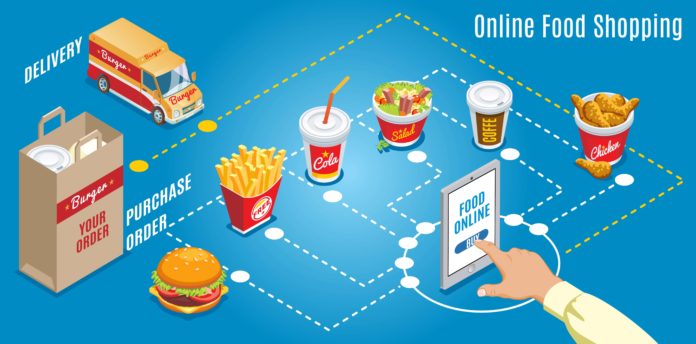Restaurants were once considered businesses that deliver utility. They were meant to cater to people who had no access to home food. Today, restaurants have become more of an extension of lifestyle. Many youngsters move out of their homes in search of a carrier, and they will have to depend on restaurant food. Even if there are possibilities to cook at home, some families prefer going out to restaurants for lunches and dinners as a mark of celebration.
The COVID-19 crisis has drastically altered the landscape of consumption of restaurants. People no longer go to restaurants because of the imposed social distancing norms and the fear of contracting the dreaded virus. In the United States, it has been estimated that 22% of the adult population preferred to order food online post the pandemic. Earlier, the figure was hovering around the 19% mark.
However, thanks to technology, many restaurants are still able to still do a good business by delivering food customer’s homes. This delivery is often facilitated by a foot delivery app. There has been an increase in demand for on-demand food delivery, and it is only expected to grow in the near future.
The Numbers That Matter:
The number of food delivery app users in the United States was around 31.4 million in 2018. It is expected to skyrocket to 59.5 million in 2023. As you might have estimated, the global market is a lot bigger than this and is bound to run into billions.
A lot of companies like UberEats and Deliveroo have already cracked not only the market but also the method of doing business. If you would like to start your own food business, all you need to do is develop an app like UberEats.
There are several ways in which you can embark on developing your food delivery app. You can consider hiring your team in house or partnering with an app development company specializing in food delivery app creation.
Both these ways, however, have their own share of demerits. They cost you a lot of money, and it also takes quite some time to get the app up and running. Even after the daunting development process, you might not always end up with a perfect product. There could be a few bugs that might interfere with the basic functions of the app. This means that you will also need to invest a considerable amount in testing the product.
Heralding White Label Solutions:
Another effective alternative to these methods is using a white label food delivery app. White label food delivery apps are alternatively known as reseller applications, and they are, in essence, products that can be acquired off-the-shelf without any branding. White label solutions are available for almost every app space, but it deserves a very special mention when it comes to food delivery applications.
There are a lot of advantages brought about by white label food delivery apps.
Since white label solutions do not have any branding, they are easy to customize. You can garnish the product with your branding elements. If need be, aspiring entrepreneurs can also embellish a lot of new features because of the ease of customizing the product. If, on the other hand, you would like to use the product as it is, it is already loaded with a lot of advanced features for scalability. It is a turnkey solution that eliminates a lot of additional costs.
White label solutions are cost-effective in multiple dimensions. Any entrepreneur will agree that time is one of the most significant currencies that they possess, and white label solutions help save a lot on development time. It also saves a lot of time-related to brainstorming, design, architecture, and testing.
All these factors culminate in facilitating easy development and deployment. In business, it is where competition is cutthroat, and even a day’s delay would mean a new competition. It is vital to have solutions that will help you launch your product as fast as possible.
Features of a white label food delivery app
A food delivery application is a grant culmination of multiple apps working in tandem with each other to affect the process of food delivery smoothly. There is an app for all the entities involved – the user, the restaurant, the delivery executive, and above everyone, the administrator.
It is the user who fuels the business, and the revenue for everyone involved lies in the user ordering food. Therefore, the user’s app should be made extremely user-friendly, and the ordering should be executed in as few steps as possible.
- The user should be able to quickly register for the services by using simple login systems like email and phone number. They should also be able to create a profile using this information displaying their default and regular delivery addresses, payment methods, and a history of their orders. If possible, the login should be made available through legacy credentials like Google and Facebook.
- The customer should be able to view all the restaurants that deliver to their delivery address.
- They should be able to make payments using digital payment methods like credit cards and debit cards for which the app should tie-up with a versatile payment gateway.
- They should be given a facility to rate their experience with the restaurant and the delivery.
- They should be provided with discounts and offers based on loyalty or pushed by a specific restaurant.
The delivery executives are people who look to earn an extra income in this world of the gig economy. They should be provided with facilities that focus on maximizing their earnings and making the entire food delivery experience a delight for the customers.
- The delivery executives should, just like customers, be able to quickly and easily sign up for the services. However, unlike customers, they will also have to undergo a process of identity verification and authentication.
- They are not employees but gig workers. Before, they should have the flexibility to choose their workers based on their availability. They should also have the right to accept or reject a request for food delivery.
- The loyalty of these food delivery executives should be rewarded monetarily. There can be bonuses unlocked for a certain number of deliveries, ad referral bonuses that might help them earn more.
- They should have their payments quickly transferred to their bank accounts, and it speaks a lot about the business’s credibility.
Restaurants view food delivery as an extension of their business but not any longer. Since the social distancing formalities mean that restaurants might not open to the fullest dine-in capacity in the near future, online food delivery is expected to be one of the most lucrative dimensions of the restaurant business. Food delivery applications have also given rise to cloud kitchens, and they can only be expected to increase in numbers in the near future.
- The restaurants should be able to register their business in the app easily.
- The app should facilitate easy upload of menu items, and if possible, the photographs and prices. The prices should be easily updatable in addition to the availability of the items, the specific time slots, and possibly, the time taken for preparation.
- The restaurant should establish its credibility by giving details of business registration.
- Most users make their payments using online methods. Restaurants should be able to get the payments fulfilled to the bank account as soon as possible.
The administrator functions like an overseer of all the functions that happen on the app. The administrator is responsible for keeping up the sanity and sanctity of the app. They should be able to access a few facilities and some powers.
- The administrator should be given access to a dashboard containing pieces of information on the app’s vital statistics, including but not limited to the total revenue, the number of active delivery executives, and the volume of sales.
- They should be able to suspend users, delivery executives, and restaurants based on quality or behavior.
- They should have the power to control the content that goes on the app, including but not limited to promotions and discounts.
Conclusion
There is no looking back for food delivery, and although the COVID-19 crisis might have slightly given it a small deep in its graph of progression, it still feels better than a lot of businesses. If you are an aspiring entrepreneur who wants to build a business out of food delivery apps, the right time is right now.
Given the availability of white label solutions, you are just a few steps away from building an UberEats clone app. All you need to do is get in touch with a company specializing in white label food delivery app customization. The white-label solution will ensure that you launch into the market in the shortest possible time, reaping bigger and better profit!









